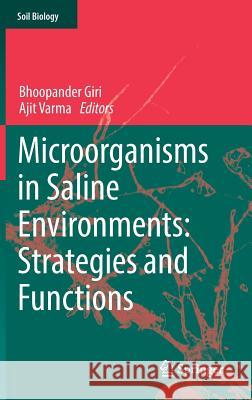Microorganisms in Saline Environments: Strategies and Functions » książka



Microorganisms in Saline Environments: Strategies and Functions
ISBN-13: 9783030189747 / Angielski / Twarda / 2019 / 466 str.
Microorganisms in Saline Environments: Strategies and Functions
ISBN-13: 9783030189747 / Angielski / Twarda / 2019 / 466 str.
(netto: 550,76 VAT: 5%)
Najniższa cena z 30 dni: 574,29 zł
ok. 20 dni roboczych.
Darmowa dostawa!
Dr. Bhoopander Giri: Received his Ph.D in Mycorrhizal Research from the Department of Botany, University of Delhi in 2001. Dr. Giri has worked as a post-doctoral fellow at the Department of Plant Pathology, North Carolina State University, USA and is currently working as an Assistant Professor at the Department of Botany, Swami Shraddhanand College, University of Delhi, Delhi. He is a recipient of CSIR Research Associateship (2003), DST Young Scientist Fellowship (2005) and Raman Post-Doctoral Fellowship. He has served as a General Secretary (from 2013-2015) for International Symbiosis Society (ISS), USA. Dr. Giri is a life-member/member of many prestigious academic societies. Besides, he serves as a reviewer for several international and national journals, including Experimental and Environmental Botany, Planta, Applied Soil Ecology, Journal of Plant Growth Regulation, Agroforestry System, Colloids and Surfaces B: Biointerfaces, Scientia Horticulture, Acta Physiologia Plantarum, Spanish Journal of Agricultural Research, Journal of Experimental Botany, Institute for Life Long Learning (ILLL), University of Delhi (e-content) and UGC-CEC (pre-view subject expert). Dr. Giri has published more than 38 papers in the national and international peer-reviewed journals and books. His paper “Arbuscular mycorrhizal fungi in alleviation of salt stress” published in Annals of Botany Oxford Press, UK has been listed among TOP 10 cited publications (from 2009-2014) in the area of Biological Science and Agriculture by International Comparative Performance of India’s Research Base, Department of Science and Technology Report 2015, India. He has presented research papers in several national and international conferences (Switzerland, Canada and USA etc.) and also served as organizing secretary. Dr. Giri has edited a book “Root Biology” published by Springer International Publishing AG-A Part of Nature 2018.
Prof. Dr. Ajit Varma: Professor Varma has completed his PhD at the age of 25 years from Allahabad University and Former Professor, School of Life Sciences, Jawaharlal Nehru University, India. Presently, he is the Distinguished Scientist & Professor of Eminence of Amity Institute of Microbial Technology; Group Dy. Vice Chancellor, Ritnand Balved Education Foundation, and Vice Chairman, Amity Science, Technology & Innovation Foundation Amity University Uttar Pradesh, India. He has published more than 314 papers in reputed journals and has been serving as an editor-in-Chief of Soil Biology Series, Springer Verlag Germany. Dr Varma is the Fellow of Alexander-von-Humboldt Society, Germany, elected Fellow of National Academy Agricultural Sciences and Fellow of Microbiology Society of India.
This book gathers the latest findings on the microbial ecology of saline habitats, plant-microbe interactions under saline conditions, and saline soil reclamation for agricultural use. The content is divided into four main parts: I: definition, genesis and impact of salinity & microbial diversity in saline habitats; II: the impact of salinity on microbial and plant life/health; III: plant-microbe interactions in saline environments; and IV: strategies for the reclamation of saline soils.
The salinization of arable land is steadily increasing in many parts of the world. An excessive concentration of soluble salts (salinity) in soils or irrigation water adversely affects plant growth and survival. This problem is exacerbated in arid and semiarid areas due to their low precipitation and high evaporation rates. In turn, poor management practices and policies for using river water for the irrigation of agriculture crops often lead to the secondary salinization of soils.
Considering the growing demands of a constantly expanding population, understanding the microbial ecology and interactions under saline conditions and their implications for sustainable agriculture is of utmost importance. Providing both an essential review of the status quo and a future outlook, this book represents a valuable asset for researchers, environmentalists and students working in microbiology and agriculture.
1997-2025 DolnySlask.com Agencja Internetowa
KrainaKsiazek.PL - Księgarnia Internetowa









